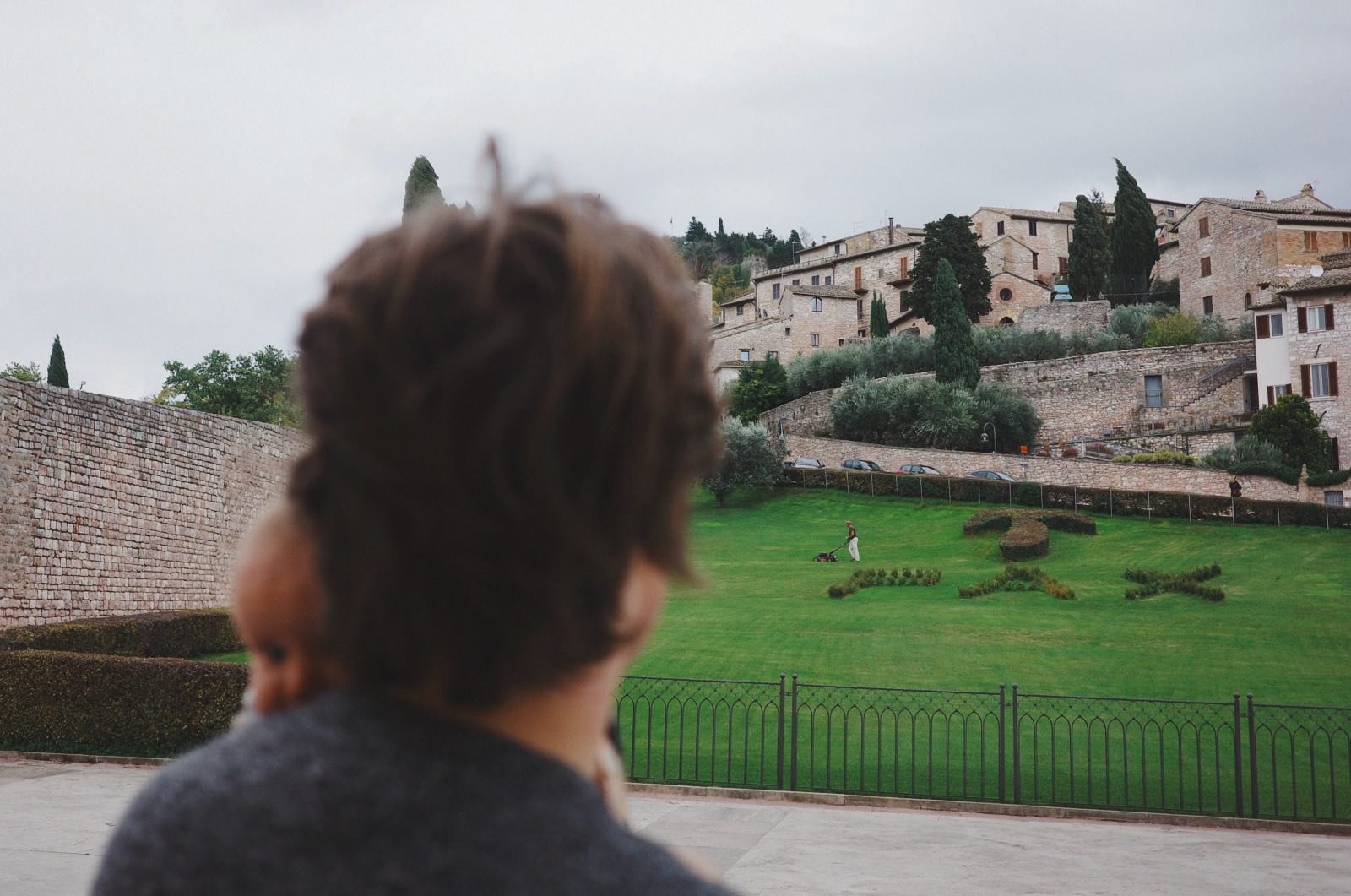No Photos Allowed
My kids outside of the Basilica di San Francesco in Assisi, Italy.
My family and I recently traveled to Italy and visited the Basilica of Saint Francis in Assisi. Kneeling under the collection of Giotto’s frescoes that depict the life of Francis, my husband and our young daughter and son knelt together in the pew of a near-empty nave. Hands clasped and heads leaned together, our kids’ eyes followed the direction of Nick’s finger, pointed up at the murals. I stood nearby with our baby, and started to draw my camera from my pocket.
But not so fast. There was a sign at the front of the parish with a picture of a camera and a red ‘X’ slashing through it. No photos allowed.
I was only trying to take a picture of my family, so my children could have a memento of this moment with their dad, inside this beautiful church dedicated to one of their favorite saints, for the rest of their lives. This is probably not a bad motive. It, in fact, might be a noble one. Yet, motives aside, I’m still asked — as all visitors are — to keep that camera in the pocket, per favore e grazie mille!
Regardless of whether the ban on photography is motivated by noble reasons* or not, I wonder what sort of invitation might linger within it for visitors (intentions of the rule aside). What good could be preserved through the Basilica’s photography ban?
Let’s think about what a camera is for. A camera extends the human capacity for sight and memory. So, when I take a picture on a digital camera, I am capturing refracted light present at a particular moment in time and turning it into an object that I can manipulate (with digital coloring, printing, or posting online) and look at in the future to recall and treasure the real life moment it re-presents. A camera is, in this way, a kind of souvenir-making device as it makes a representation of anything placed before its lens.
What then happens to me when I use a camera? How is the camera shaping and forming my way of imagining the world and my place within it? When I take a photo, I am training myself to take something (namely, a picture) from what I see for the end of obtaining an image, which represents that which I saw, and that I can hold and grasp as my own. An image taken of a moment in time is, notably, quite unlike the real moment in time, which I cannot hold and grasp as my own.
What good then might be preserved by prohibiting cameras in a space like the Basilica of St. Francis? The prohibition can dispose the tourist to become more than just a tourist; that is, to become a family member residing in the homeland of God — the Church — wherein one may take refuge amongst the family of the saints, and be nourished by the ever-living God who gives himself to us in the sacram life of the Church.
Instead of taking something from the space for my own benefit (in this case, a photo), I can — free of my own devices — be taken in by the space. Rather than simply passing through it unaffected, in indifferent admiration, I can dwell and participate within it. I guess what I’m trying to say is that the prohibition can help prepare the visitor to make an act of faith, which never begins with the act of taking, but being taken in and received.
And in that particular space of the Basilica of St. Francis, visitors are invited to not just learn about St. Francis as a historical figure, but be immersed in his story as a person who embodied the love of God, during his life on earth and in his continued life in heaven. As the theologian Hans urs von Balthasar writes, the life of a saint is an expression of the truth of the Gospel — that Great Story to which I too am called to embody with my life through communion with Christ. In the Basilica, I can more freely enter into that reality, if I leave behind that which might prevent me from taking up such a posture of openness and receptivity.
At this point, I’m aware that I am theologizing a rule that I do not know the intention behind. This is a practice that I think should be avoided, especially when it comes to matters of faith! Reading into a teaching something that’s not actually there can lead to a distortion of the truth that the teaching was intended to preserve; it can also lead to the elevation of behaviors and practices that shouldn’t be elevated, but revised. All of this to say: the point of this reflection is not to speculatively explain the rule, nor to defend it, but to offer a different way of entering into that sacramental space beyond the narrow lens of a camera.
While having a photo of Nick and the kids would have been a sweet keepsake (and one I definitely would have taken if there hadn’t been that sign!), I’m grateful to have instead bore witness to that moment of love, in that familial space made for people to encounter the Source of that love — rather than just trying to capture a piece of it for myself.
Now, please enjoy a few pictures I took of my family outside of the beautiful Basilica. Cheers, friends.
*In some churches and museums, for instance, flash photography is prohibited because the flash can damage the artwork.




